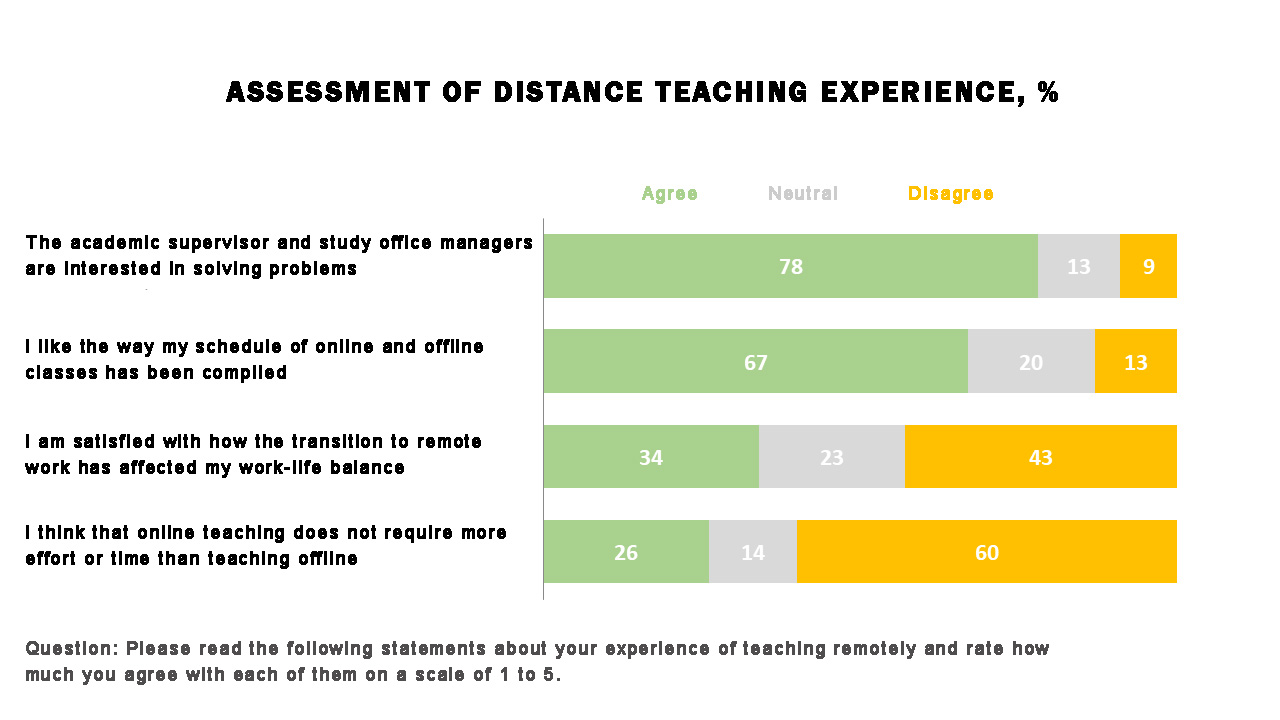- A
- A
- A
- ABC
- ABC
- ABC
- А
- А
- А
- А
- А
HSE University Staff Feedback on Remote Work
© Daniil Prokofyev/ HSE University
In November and December 2020, the Centre for Institutional Research conducted a monitoring survey of HSE faculty and staff. A major section of the survey was dedicated to the transition to remote teaching, including the impact of the online format on the complexity of teaching, changes in the educational process, student involvement and other aspects. A total of 784 teachers took part in the study. HSE Life shares the key results.
Online teaching is more energy-intensive

Teachers gave a fairly negative assessment of the impact of the remote format on workloads and time management. Only a quarter agreed that online teaching is no more time-consuming, and only a third positively assessed the impact of the format on their work-life balance.
‘The fact that teachers consider new work technologies to be more time-consuming reflects their responsible attitude to their work. During a difficult academic year, we had to change from the usual technologies and teaching methods. Teachers spent more time and effort on learning new things,’ explains Anna Korovko, Senior Director for Full Degree Programmes.
Despite potential concerns about older HSE employees, who it might be assumed are more used to traditional teaching formats, the complexity of the educational process turned out to be more related to experience than age. Some teachers found it difficult to change their usual approaches to teaching and time management.
Equipment and digital skills had a greater influence on the remote working experience than the individual characteristics of the respondents. Those who mentioned having all the necessary equipment evaluated their remote work experience much more positively.
‘The data clearly shows that tech-savvy teachers are much more positive about the transition to remote learning than their less digitally inclined colleagues, and this is quite natural,’ says Olesya Klychikhina, Head of the Unit for Strategic Digital Development and Partnerships. ‘The help requests we receive through the HSE hotline show increased anxiety among teachers related to any changes in the use of digital services. For example, requests currently concern the switch from the Zoom platform, which our teachers have got the hang of, to alternative communication platforms as part the educational process. This once again confirms that HSE University chose the right policy to improve digital culture and gradually introduce professional competence standards for HSE employees. This policy outlines the requirements for digital literacy, the development of continuing education courses, ongoing training and consultations on the use of digital services in education.’
Digital tools and interactive elements are more actively involved in teaching
The most common practices among teachers were assembling students into groups on Zoom and using digital testing tools. The use of special digital tools for group work (for example, Miro) is typical of only 11% of teachers, and 18% of teachers mentioned the use of gamification tools. Only a small group of teachers use pre-recorded lectures in their courses (5% use their own, 3% use lectures by other specialists).

‘There is a wide variety of academic disciplines at HSE University, so teachers work on the educational process in the digital environment in their own way and using the tools that suit them. The 15% of teachers who use digital tools not listed in the survey clearly demonstrate this. We see that teachers and teaching skills are constantly adapting: new teaching techniques are being invented in the digital environment, and a new teaching logic for online and blended formats is being created,’ says Olesya Klychikhina.
About a quarter of teachers (23%) were conservative about digital tools and noted that almost no changes were required when switching to an online format. This attitude correlates with age: only 11% of the youngest employees agreed with this opinion, and the number of those who share this attitude gradually increases with age, reaching 32% among teachers aged 60 and over.

Student involvement in online learning is lower in several areas
The figures for participation in discussions (27% lower online than offline) illustrate this tendency. The proportion of teachers who report that the majority of students fully master the course materials through self-study in the remote format is 16% lower. Teachers also note that class attendance decreases by 14%, despite the reasonable assumption that the lack of time spent travelling to university and back might have a positive impact. Only 16% of teachers noted that students turn on their cameras during classes.
According to Anna Korovko, in addition to students’ self-study skills, this reflects the need to master new methods of online teaching. ‘Given the trend towards intercampus courses, as well as open access for students from other universities and those who want to study courses and modules at HSE University, we need to build experience in improving involvement among students of the same year, but in different cities, and share it among departments. This year, HSE University will organize special events dedicated to this problem for teachers,’ says Anna Korovko.

The amount of student requests for advice from teachers remained almost unchanged.
‘The data obtained shows that teacher consultations have the greatest potential to increase student involvement: in this regard, we saw the smallest difference between offline and online formats. Students are interested in communication, and they are open and ready to communicate with us. This is a very useful and positive conclusion of the research, and one which faculty and staff should think about,’ says Olesya Klychikhina.
Project activity and the Data Culture project were the highest-rated elements of the education system
The inclusion of both project activity in the educational process and mandatory data analysis courses in bachelor's programmes received the highest ratings from the teachers surveyed.
28% of teachers positively assessed the opportunity to organise joint courses for students of different HSE University campuses, and slightly fewer teachers (24%) approve of the mandatory transition of the university-wide course pool to an online format.

As for online teaching in general, employees with more than 10 years of work experience are the most sceptical of the idea, as they have already formed their own approaches that may not be as well-suited to the online format.
Regarding the use of proctoring for assessment in online learning, a quarter of teachers expressed a positive opinion, 39% had neutral feelings, and 17% were unsure.

